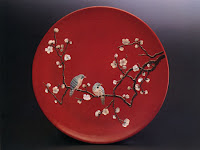
 Some people here believe that the origin of urushi began in China, where they found what an urushi made 7000 years ago. However, an archaeologist in Japan found a piece of urushi in Hokkaido, dated back to 9000 years ago. This one and only piece of proof that urushi started in Japan was lost in a fire. Until today the archaeologists are still investigating the history of urushi and accepting the possibility that urushi might have came from China over 10000 years ago, along with the very rare, unique and skilled techniques of its making.
Some people here believe that the origin of urushi began in China, where they found what an urushi made 7000 years ago. However, an archaeologist in Japan found a piece of urushi in Hokkaido, dated back to 9000 years ago. This one and only piece of proof that urushi started in Japan was lost in a fire. Until today the archaeologists are still investigating the history of urushi and accepting the possibility that urushi might have came from China over 10000 years ago, along with the very rare, unique and skilled techniques of its making.I think urushi is a very special piece of artwork and i have seen some extraordinary pieces of urushi in Fukushima, Aizu
. Whether the origin was indeed China, i believe that Japan has for the past thousands years master the production of "urushi", now known as "Japanese lacquer" in English.

Urushi is made from a special tree, called urushi tree or black tree, where you derive a nature made lacquer to make black, dark red or red color depending on the process and species of trees. Japan has a long history and culture in the making of urushi just the same way China does in the making of ceramics (well known as bone China). In English "urushi" is called Japan ware or just Japan.
The making of urushi involves an elaborate work of maintaining a certain temperature at every single steps. Urushi, which is strong against heat, humidity, acid or alkaline, is used to make traditional kitchen ware (cha-zutu or ocha-container, bowl, bento/lunch box, etc.), Japanese instruments (such as koto) and furniture. However, urushi is weak when it comes to direct sunlight or UV. It is also weak against sudden change in temperature and humidity. The piece may break or develop a crack over a period of such exposures. Golden color used in urushi is made with a real gold powder and involves an elaborate work of putting it layers over layers, more than 100 times.

When you buy urushi for kitchen ware, you may wonder how to use and wash them. Here are the common rules for keeping your precious urushi (from the Aizu Urushi Foundation):
1. No direct contact with fire (which is obvious since it is made of solid wood)
2. Do not put them in microwave, oven, fridge, dishwasher.
3. When you use hot water (whether during washing or making tea - as for teapot), you need to understand that the color of urushi will change over a period of time. In order to maintain its beauty, you are supposed to dip the urushi into a slightly warm water before using hot water, or in other words, to avoid the sudden change of temperature, you need to prepare a few steps of work.
4. If you have urushi cups - that you use to serve tea, the same process is needed to maintain its color and to avoid cracks. Also make sure that you do not leave any liquid for a long time in such urushi since it will affect . After washing, it is better to wipe it dry with a towel instead of leaving it dry naturally.
5. For a long time storage urushi is best kept at a certain humidity, therefore it is recommended that you store it in a cupboard with a cup of water to maintain humidity.
Now you may ask me why Japanese like to use such a kitchenware that requires elaborate work just to maintain it. I think it is indeed a Japan ware, rooted with a deep Japanese culture, since it requires elaborate work making it, it is only fair that you need to put elaborate work maintaining such a piece of art.

No comments:
Post a Comment